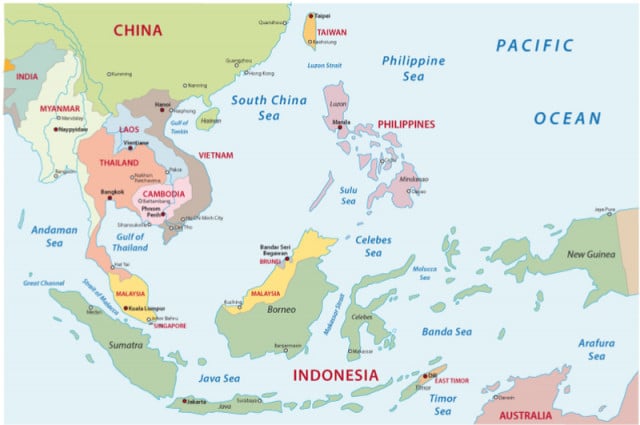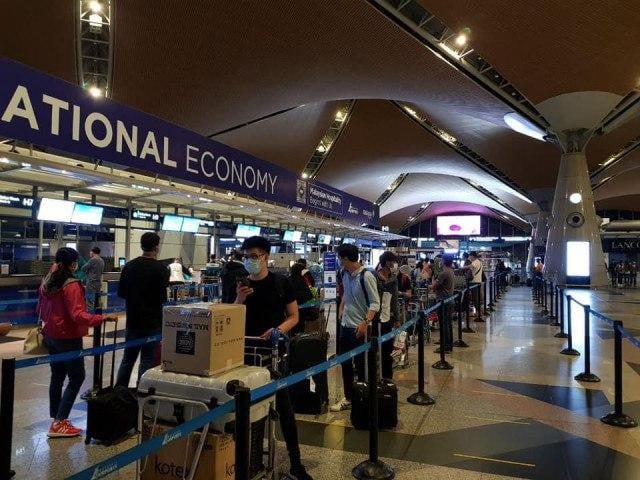Mainland Southeast Asia: a Strategic Position for China’s Sea Power Projection

- Chen Heang
- October 6, 2020 10:47 AM
Between a growing need to find alternative energy supply routes beyond the Malacca Strait and the rising tensions in the South China Sea, China is increasingly looking to capitalize on the advantages of mainland Southeast Asia.
Mainland Southeast Asia’s geographic features place it in a strategic position for competition by the two powerful Asian nations of China and India, who are joined at the region’s land boundaries, along with the South China Sea and the India Ocean beyond the mainland’s coastline.
This Lower Mekong Subregion, namely Myanmar, Thailand, Laos, Cambodia, and Vietnam could assist China to unify its power by sealing off any potential maritime nations from its adjacent sea and pursuing far sea defense. If China dominates mainland Southeast Asia, it will have unopposed control of the sea in this region.
As such, each country’s geography needs to be taken into consideration. Thailand is a good to start a discussion. The fact is that Thailand’s proposed Thai Canal (Kra Canal) could give China the edge. This canal would conjoin the Andaman Sea and the Gulf of Thailand through the Malay Peninsula, creating a thoroughfare for China to escape the Malacca Dilemma—where the US navy and its allies could effortlessly block China's energy supply routes.
Consequently, a mixture of Chinese and Thai companies have made many attempts to advocate for the project, including China’s Maritime Silk Road Initiative and the Thai Canal Association (TCA), both of which have been wielding their influence on the project, but Beijing is reportedly keen to provide financial and technological assistance.
Even though Beijing’s statement is, on the surface, supportive of pushing the Thai canal project forwards, many Thai analysts believe that Beijing is quietly pushing Chinese companies to become involved with the project.
Even this proposal is seemingly gone, the nature of Thailand’s geography remains strategic for China, who likely sees more opportunities to come. As a matter of history, it tends to believe that this Thai canal will be influenced by China in the way that powerful sea power nations have controlled strategic waterways in centuries gone by; Britain controlled the Suez Canal in the 19th century, while the US occupied the Panama Canal throughout the 20th century. Thus, for the 21st century, China hopes to control the Thai Canal.
Given a similar strategy, Myanmar’s land could also be available for China as a means to reduce its dependency on shipping through the Strait of Malacca. Myanmar is perceived more significant due to the shared boundary with China and the Indian Ocean. Clearly, China’s oil and gas pipeline highlights the significance of Myanmar’s position, as this pipeline runs through Myanmar directly to China’s Yunnan province.
Besides this, the Western coast of Myanmar is also considerable—it’s just a few hundred miles away from the easternmost Indian-held island. Analysts remain concerned over the dual-use port for supporting China’s navy due to the high levels of Chinese investment.
But Myanmar’s potential isn’t just an opportunity to offset China’s reliance on the Malacca Strait, it could also help divert Indian influence away from Southeast Asia’s mainland by creating a security network from Myanmar to Pakistan—effectively surrounding India by passing through Sri Lanka and Bangladesh at the Bay of Bengal. Even though these two countries would give China some security advantages, the adjacent sea must also be protected.
Disputes between China and Vietnam will to create sophisticated levels of competition within the region. Apparently, Vietnam’s claimed area overlaps China's nine dash-line, while other claimant states tend to demand nearby islands. This conflict of interest pushed Vietnam to become a muscular rival of China, however if Vietnam loses out to the superpower, it may end up seceding half of the South China Sea.
Citing a top US official in his book, Asia’s Cauldron, Robert Kaplan writes “Malaysia is lying low, Brunei has solved its problem with China, Indonesia has no well-defined foreign policy on the subject, the Philippines has few cards to play despite that country's ingenious boisterousness and incendiary statements, Singapore is capable but lacks size.” Couple this with silencing Vietnam, China could gain a robust stance to defend and dominate the sea. Regarding this competition, neighboring countries of Vietnam are possibly involved.
Laos, the only landlocked country in this group, seems less strategic for China in terms of sea power projection. However, combining with Cambodia’s map, it can generate a tactical line from China’s Southern border to Southern part of Vietnam, surrounding its competitor’s partners which would create unfavorable conditions for Vietnam.
Concerning the South China Sea crisis, Phnom Penh and Vientiane’s reluctant stance has been seen as the price for China’s huge financial assistance and investment. Through these two countries’ borders, China could reach the Gulf of Thailand. This fact further convinced some analysts of the Wall Street Journal’s report on a secret deal between China and Cambodia regarding a naval base, despite repeated denials by both Chinese and Cambodian officials. However, if it were possible, it would set up a triangle perimeter which would enable China to commit to more opportunistic activities around the disputed area.
This begins to suggest that mainland Southeast Asia would give China the status of an influential sea-power nation in the region. One cannot ignore the importance of this mainland’s geography to China, especially the potential to create a sea expressway that would allow China to avoid directly confronting the US and its security partners in the Malacca Strait. The ongoing debate still remains whether China can withstand Vietnam’s claims in the South China Sea or resurrect the proposed Thai Canal project.
Chen Heang is a fresh graduate with a bachelor’s degree in International Relations from the University of Cambodia. He has participated in numerous conferences and workshops across ASEAN. All views expressed are his own















